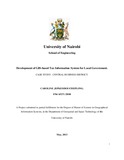| dc.description.abstract | Property tax is one of the most important sources of income for the Nairobi County Council and accounts for nearly one third of its annual revenues. This source of revenue is the least tapped and supports urban governments in Africa. Rates are essentially a local tax paid by occupiers of land and buildings as a contribution towards local services. In Kenya, discussions on property taxation are becoming increasingly important within the various authorities as more responsibilities are devolved to county governments.
As Nairobi City is expanding rapidly, new structures are coming up along all the transportation corridors. Since rates are payable on immovable property it is impossible to avoid paying them and therefore local authorities have a stable form of income. So it is imperative to assess all these existing unimproved sites and maintain an effective database for easy collection of property taxes.
As far as Nairobi city is concerned, the property tax details are maintained manually and involves a lot of human interaction. The officials are not able to collect the property tax efficiently and hence they fall short of the budget estimate.. So if the tax details are maintained electronically (spatial details incorporated),many studies have indicated that the efficiency of tax collection can be improved and a higher degree of transparency achieved. Meaningful development activities can be taken up only by proper realization of property taxes.
The aim of the project is to develop a GIS based Tax Information System enabling spatial query, visualization, efficient updating and processing of property tax records. The spatial dimensions of the all structures can effectively be maintained in a GIS (Geographical Information System) environment. The Information system developed incorporates all the spatial and non-spatial details regarding the built up structures for effective maintenance, collection and updating of property tax information. The system entails the digitization of all maps with the inclusion of necessary information on every piece of land and the possibility of linkages with other offices.
This system will be used as an aid for inspection, verification of owners for location of properties, generation of vicinity maps, identification of over-lapped properties and to identify duplicate assessment of real properties and land rates defaulters.
xii
During the study, various analysis were undertaken to verify the functionality of the database and the tasks it can perform in relation to various commands and queries (SQL) performed. To determine this, data analysis through selection by both attribute and location were performed. When queried the database through selection by attribute, rates defaulters, non defaulters and public lands (unrateable lands) could be highlighted graphically.
In conclusion, it can be evidently and confidently be conclude, that the objectives of the project were achieved. This research study looks how Geographical Information System (GIS) can be adopted by local authorities as an effective tool for managing, organizing and analyzing spatially related data. A large percentage of decisions made by Local Authorities are spatial based in nature. Local Authorities can benefit from the existence of a GIS to aid in decision making during the preparation of development plans such as structure plans, local plans, and layout plans. | en |

